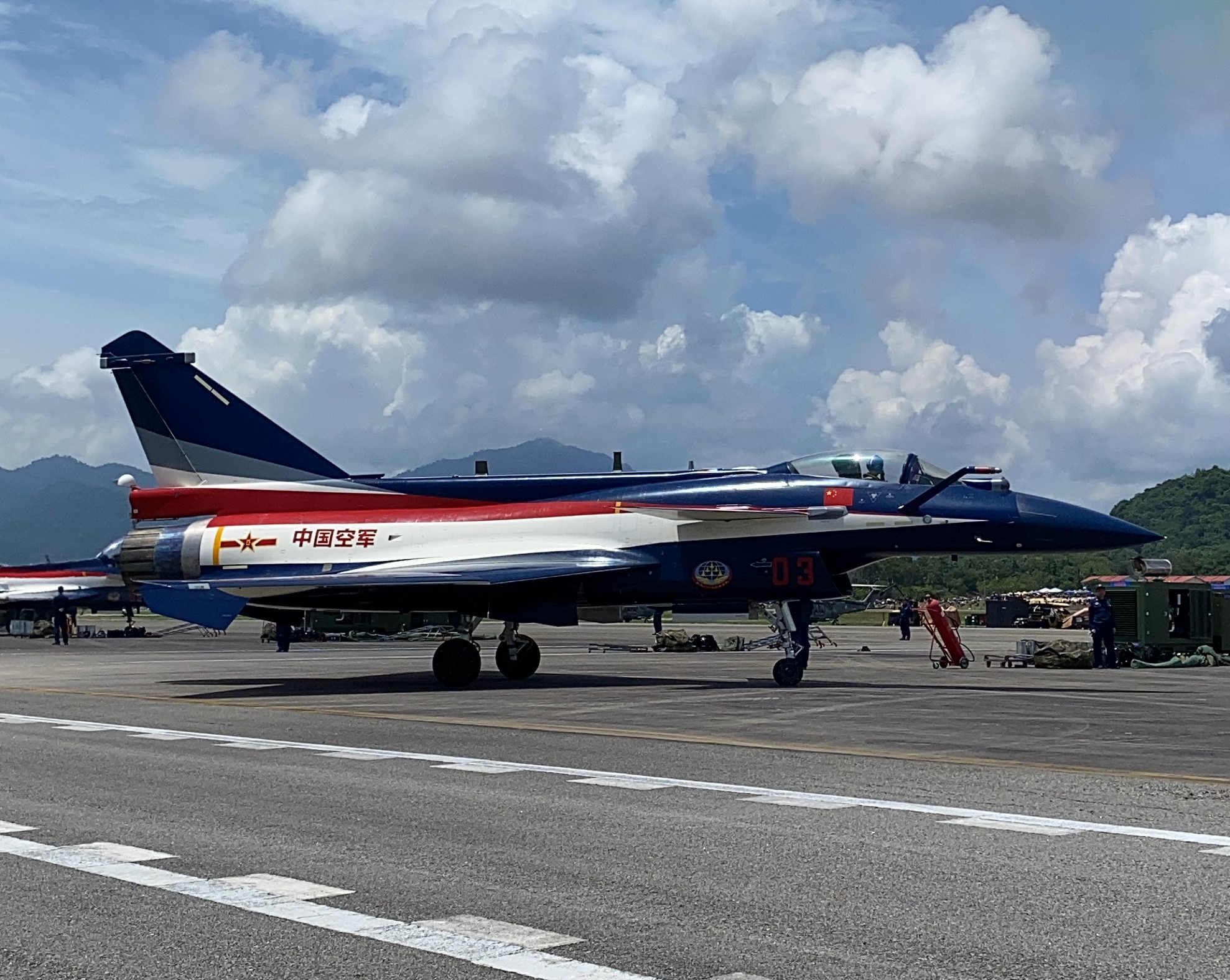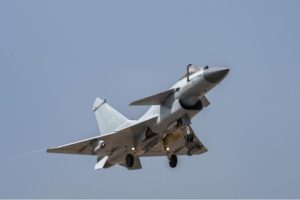
Egypt is Rumored To Have Signed Purchase Agreement for Chinese J-10C Fighters
By Lucas Winter

PLAAF J-10C in action during the 2023 Langkawi International Maritime and Aerospace (LIMA) Exhibition in Malaysia.
“The decision [to acquire Chinese J-10C fighter aircraft] comes at a time of geopolitical realignment for Egypt.”
Unconfirmed reports indicate that the Egyptian Air Force may soon acquire the export variant of China’s J-10C fighter aircraft.[i] If confirmed, this would represent a clear deepening of Egypt-China military ties amidst growing regional uncertainty due to the conflict in Gaza.[ii] Although the deal remains unconfirmed by either side, various English- and Arabic-language media outlets are treating the acquisition as a fact.[iii] Many analysts and commentators, noting Egypt’s recent accession into BRICS, portray these developments as signaling an ongoing shift in Egypt’s security partnerships from the United States toward closer relations with Russia and China. The first two accompanying articles, from defense-arabic.com—an Arabic-language defense news website and discussion forum—and RT Arabic—a Russian media outlet—illustrate the kind of reporting driving this narrative. For its part, the defense-arabic.com article suggests that Egypt’s decision to do so “reflects Cairo’s intention to diversify the sources of its military equipment and thus reduce its dependence on American defense systems.” Interestingly, the RT Arabic article sources its story from an Israeli news site, nziv.net, whose reporting has portrayed Egypt as a latent security threat to Israel.[iv] Global and regional actors are likely to use this story regardless of the finalization of the deal, to further broaden agendas, particularly the notion of a growing rift between the United States and Egypt.
The strategic implications of Egypt acquiring Chinese fighter jets may be less dramatic than some predict, as suggested in the third accompanying excerpt from the prominent daily al-Araby al-Jadeed. Egypt has long pursued a policy of diversifying its arms suppliers, and it has considered upgrading its fighter aircraft through deals with Europe, the United States, and Russia. However, the region’s heightened tensions and increasing geopolitical competition could interpret even relatively routine actions as strategically significant, warranting closer attention.
Sources:
مصر تعلن رسميا اختيارها للمقاتلات الصينية J-10C لتحل محل مقاتلات F-16 الأمريكية
“Egypt officially announces its choice of Chinese J-10C to replace it’s American F-16s,” defense-arabic.com (defense news and discussion forum), September 11, 2024. https://tinyurl.com/vyfmemsj
Egypt has officially announced that it will replace its aging fleet of American F-16s with Chinese J-10C “Vigorous Dragon” fighters, after discussions that have continued over the past few months. The decision, announced during Egypt’s first international air show, reflects Cairo’s intention to diversify the sources of its military equipment, and thus reduce its dependence on American defense systems…
The decision comes at a time of geopolitical realignment for Egypt, which recently joined the BRICS bloc alongside major players such as China, Russia and India. In recent years, Egypt has also acquired defense equipment from Russia and France, including the MiG-29M and Dassault Rafale. The Chinese J-10C is set to become a key part of Egypt’s diverse arsenal.
Source:
“مصر تستبدل مقاتلات F-16 بمقاتلات صينية متطورة”.. الإعلام العبري يتحدث عن الصفقة المنتظرة
“Egypt replaces its F-16 with advanced Chinese fighter jets… Hebrew media speaks on the presumed deal,” RT Arabic (Russian media outlet), September 9, 2024. https://tinyurl.com/p9nk35mf
According to Hebrew media, the Egyptian Ministry of Defense has placed its first-ever order to purchase Chinese fourth-generation fighter jets, with an unspecified number of J-10C aircraft ordered on August 19. According to the Israeli news website “nziv”, this development comes at a time when Cairo continues to strengthen strategic and economic relations with Beijing, after joining the BRICS bloc earlier this year…
The website added: “With the exception of three squadrons of MiG-29M fighter jets that Egypt ordered from Russia in 2015, all of Egypt’s fourth-generation fighter jets are of Western origin, and the purchase of the J-10C is seen as a potential turning point for Egypt.” The Hebrew website report explained that Egypt is seeking to gradually stop relying on American weapons, especially since the United States had previously refused to sell the latest F-15 aircraft to Cairo, while it agreed to sell them to Israel, which angered the Egyptians. The website pointed out that the United States may stop the annual grant of billions of dollars to Egypt if it buys fighter jets from China.
Source:
هل تتجه مصر نحو اقتناء مقاتلات صينية؟
“Is Egypt moving toward purchasing Chinese fighter jets?” al-Araby al-Jadeed (Qatari-aligned daily), September 15, 2024. https://www.alaraby.co.uk/politics/هل-تتجه-مصر-نحو-اقتناء-مقاتلات-صينية
However, Dr. Merit Mabrouk, director of the Egypt Program at the Middle East Institute in Washington, believes that Egypt cannot replace the United States with China and Russia in terms of its total reliance on armaments. She explained to Al-Araby Al-Jadeed that “as for Russia, Egypt cannot buy weapons from it, because American law stipulates that military aid is not granted to countries that buy weapons from Russia, and Egypt is one of the largest countries that receive American military aid.” She added that “as for China, Egypt’s cooperation with it in the military field is not a replacement for the United States, but rather a kind of completion and diversification of weapons sources.”
“The United States was and will remain Egypt’s favorite, and it is Cairo’s first partner in this field, but it decided some time ago to expand its contacts and partnerships, and that it will not limit itself to one partner, because it is not in its interest,” Mabrouk said. “The idea is that Cairo gives itself the right not to be forced to deal with Washington alone in this field, despite its strong desire to deal with it, and this is not only for Egypt but for many other countries,” she added.
Notes:
[i] In 2022, Pakistan became the first country to obtain the Chengdu J-10 (NATO reporting name is Firebird). If the rumors are confirmed, Egypt would become the second country to acquire the J-10. The J-10 is a relatively old aircraft, declared operational in 2003, and designed primarily for air-to air combat. However, the J-10 can also perform and participate in strike missions. In January 2024 Pakistan J-10CE’s escorted drones on a strike mission against Baloch separatists in Southeastern Iran.
[ii] In late August, Egypt hosted its first-ever International Military Airshow, where the J-10C was prominently displayed, and an alleged agreement was reportedly finalized. Egypt’s interest in the J-10C has been public for over a year, and negotiations seem to have accelerated in recent months. See for instance this May 2023 article mentioning Egypt’s interest in the fighter jets: “China in advanced negotiations for major arms deals with Egypt and Saudi Arabia,” The New Arab, 25 May 2023. https://www.newarab.com/news/china-advanced-talks-major-saudi-egypt-arms-deals; Last July, the Egyptian Air Force commander visited Beijing for discussions with his Chinese counterpart. See:
قائد القوات الجوية يلتقى نظيره الصينى
“Air Force commander meets his Chinese counterpart,” Egyptian Ministry of Defense, 16 July 2024. https://tinyurl.com/ycj3yb6t
[iii] In addition to Arabic-language outlets, an article in The National Interest reported the sale as a fact without providing evidence. See: “The Mighty F-16 Fighter Just ‘Lost’ to China’s J-10 (But Not in Battle),” The National Interest, 13 September 2024. https://tinyurl.com/6kcmcywy
[iv] See for instance: “Israel spreads false allegations to downplay severity of its military setbacks: Source,” Egypt Independent, 30 May 2024. https://www.egyptindependent.com/israel-spreads-false-allegations-to-downplay-severity-of-its-military-seStbacks-source/ and “Egypt ‘preparing for another Yom Kippur War,’ warns Israeli media site,” Middle East Monitor, 16 July 2024. https://www.middleeastmonitor.com/20240716-egypt-preparing-for-another-yom-kippur-war-warns-israeli-media-site/
Image: PLAAF J-10C in action during the 2023 Langkawi International Maritime and Aerospace (LIMA) Exhibition in Malaysia.
Source: https://commons.m.wikimedia.org/wiki/File:J-10C_LIMA_2023.jpg
Distribution A: Approved for public release
Categories:
Tags:
Related Products
Chinese Military Exercises Highlight Improvements in Joint Operations






